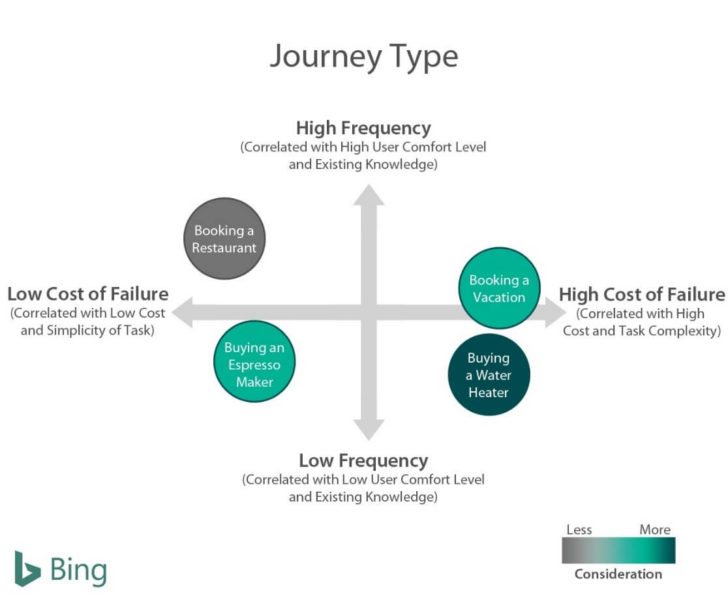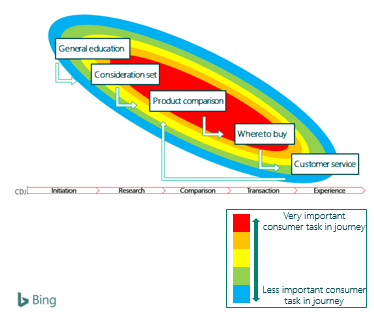New insights on the customer decision journey
Columnist John Cosley shares research from Bing Ads on the customer journey and explains how you can apply these learnings to optimize your paid search campaigns.

For years, paid search has centered around clicks. Getting the most clicks. Getting the highest click-through rate. Marketers have obsessed at delivering the most clicks for the lowest cost. But who is behind all of those clicks? And what are they really looking for?
New research at Bing Ads now allows us to better understand the customers behind those clicks and where they are in the customer decision journey (CDJ). Such insights not only help advertisers to optimize their campaigns, they also help to further search as the personal assistants of tomorrow.
But before we get into search, we first need to understand the consumer mindset and the science behind each customer’s decision journey.
All consumers go through five distinct stages, which vary depending on the type of purchase: initiation, research, comparison, transaction and experience. Whether you are hopping online to replace a broken espresso maker or find yourself in the rather unpleasant market for a new hot water heater, you are subject to the same five CDJ stages, although they will vary in length and importance.
For the espresso maker, you’ll probably skip the initiation and research stages and start to compare models for an immediate purchase. For the hot water heater, you’ll need much more time to get educated before making a decision. Who knew the future of water heaters was tankless? And that a tankless water heater could save you hundreds each year? You’re now ready to enter the comparison stage.
Identifying consumer journey types
In order to better understand the unique journey types all consumers go through, researchers created the continuum chart below that compares two driving factors within every purchase: frequency of a purchases against the potential cost of failure.
These two elements will help advertisers pinpoint the consumer mindset and which CDJ stages are most important to their customers. Highly frequent, high-cost-of-failure purchases place customers on a deeply considered journey type. Infrequent, low-cost-of-failure purchases place consumers on a slightly considered/habitual/impulse journey type.
Once you’ve established your customer’s journey type, you can delve even deeper to identify their exact stages on the customer decision journey.
Deeply considered journeys
If most of your consumers are within deeply considered journeys, it will be important for your brand to appear within each stage of the CDJ. Your search strategy should be to help consumers initiate, research, compare, purchase and continue with a follow-up.
You should develop content around research, buying guides, ratings, reviews, features, pricing, availability and future services. Your customers span across various stages and are thinking, “What are my options?,” “Do I need one?,” “Which model got the best reviews?” and “How much will it cost?”
Impulse journeys
On the other hand, if your customers center mostly around shorter/habitual/impulse journeys, then it is highly important to appear at the critical purchase stage. Your content should focus on ratings, reviews, pricing, promotions and local targeting. Your consumers are thinking, “Which stores have the best deal?,” “Are there coupons available?” and “How quickly can I get it?”
Putting the CDJ into action
As the search providers continue to invest in tools and capabilities to target audiences, it becomes increasingly important to understand user intent and the consumer mindset. Consumers expect search results that are personalized, localized and actionable. They are shouting, “What is a tankless water heater?” from across the room to their Amazon Echo. They’re searching for espresso makers on their phones. And in their cars. Tomorrow’s leading advertisers need to be ready with contextualized content delivered at the right moments.
Now is the time to move away from the click mindset and start building out strategies to better connect with your customers.
In order to best reach customers in deeply considered journeys, consider the following:
- Leverage site links that allow consumers to self-identify their CDJ stage, and immediately take them where they want to go.
- Create custom landing pages for the different stages of the CDJ. “What is a tankless water heater?” should lead to an educational page. “Which is the best water heater?” could lead to a comparison page of your top 10 water heaters.
- Create longer-tail keyword phrases to catch voice and mobile searchers within different stages of the CDJ. Keywords are your #1 identifier of consumer intent and CDJ stage.
- Place UET tracking tags on your site and set up remarketing campaigns which will enable you to reach consumers throughout their journey.
If you are trying to reach customers on impulse journeys, consider the following:
- Leverage data feeds to show up on Product Ads and bid aggressively. Bing product ads display a high-res photo of your product, pricing and promos.
- Focus on “Where.” The keyword “where” signals an intent to buy, especially on voice searches, and it should appear frequently within your campaigns.
- Be sure your campaign and site are mobile-friendly to catch consumers on the go.
- Set up remarketing campaigns targeting users with strong intent signals, such as those demonstrating product page engagement and shopping cart abandonment.
Search is no longer text in a box. It is moving into the fabric of our lives across the devices of tomorrow. Bing will continue to leverage consumer insight research to enlighten advertisers and delight searchers with personal, contextual results.
Contributing authors are invited to create content for Search Engine Land and are chosen for their expertise and contribution to the search community. Our contributors work under the oversight of the editorial staff and contributions are checked for quality and relevance to our readers. The opinions they express are their own.
Related stories
New on Search Engine Land



